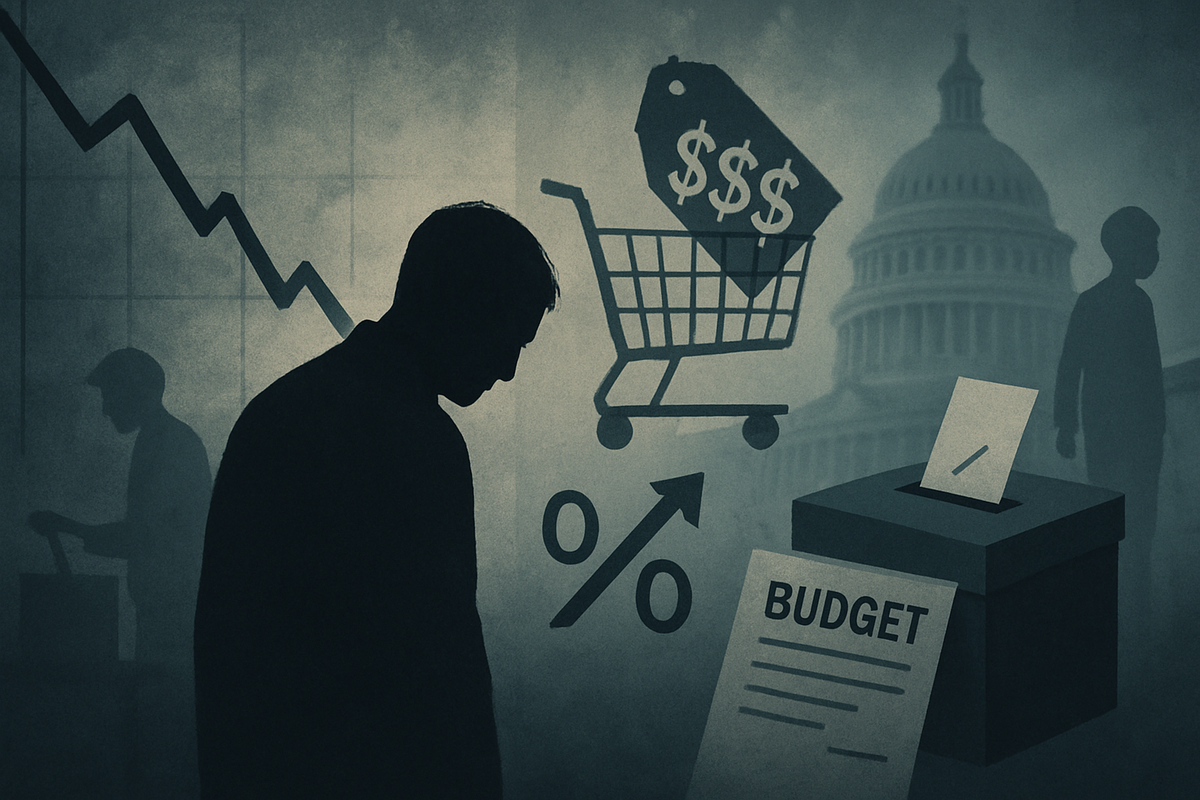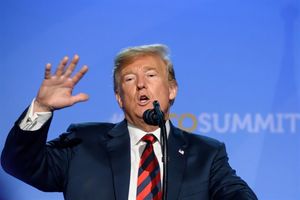Financial News
Rising Tide of Economic Pessimism Grips America as Midterms Approach

A new wave of national polls reveals a deepening sense of economic gloom among Americans, with a significant majority now believing the nation's financial health is deteriorating. This pervasive pessimism, fueled by persistent inflation, elevated interest rates, and a softening job market, presents a formidable challenge to policymakers and could significantly reshape the political landscape as the 2026 midterm elections draw closer. The data, compiled from various reputable sources, paints a picture of a populace increasingly wary of their financial future, a sentiment that could translate into tangible shifts in consumer behavior and electoral outcomes.
This widespread apprehension is not merely a transient mood but reflects a fundamental erosion of confidence in the economic trajectory, with potential far-reaching implications for consumer spending, business investment, and the political fortunes of incumbent parties. The confluence of economic headwinds suggests that the coming months will test the resilience of both the American household and the broader market, demanding careful navigation from all stakeholders.
Deepening Economic Gloom: A Nation's Waning Confidence
The latest economic sentiment indicators, notably from Pew Research Center, University of Michigan, and CBS News/YouGov, paint a stark picture of American apprehension. As of October 2025, approximately three-in-four U.S. adults (74%) describe current economic conditions as "only fair or poor," a sentiment that has remained stubbornly high since early 2024. More acutely, a majority of Americans (59%) now believe the economy is "getting worse," an increase from 54% in July, according to CBS News/YouGov. This marks a concerning acceleration in negative sentiment, moving beyond mere dissatisfaction to an active belief in economic decline. The University of Michigan's Consumer Sentiment Index further underscores this, stagnating near historical lows at 55.0 in October 2025, a significant 22.0% decline year-over-year.
This growing pessimism hasn't emerged overnight but has intensified steadily throughout 2024 and 2025. Persistent high inflation, particularly for everyday necessities like groceries, has eroded purchasing power and remains the top concern for most households. The Federal Reserve's (FED) sustained high interest rates, while aimed at taming inflation, have made borrowing expensive, impacting everything from mortgage rates—which have made homeownership increasingly unattainable for many, as highlighted by Fannie Mae's Housing Survey—to durable goods purchases. Furthermore, the job market, once a beacon of strength, is showing signs of weakening. The Conference Board's Consumer Confidence Index (September 2025) noted a decline in consumers' appraisal of current job availability for the ninth consecutive month, with expectations for future job availability also dimming. Job growth has nearly stalled in the three months leading up to August 2025, stoking fears of rising unemployment and even a potential "stagflation" scenario.
Key stakeholders involved in this economic narrative include the American consumer, who is feeling the direct pinch of rising costs and stagnant wages; businesses, grappling with slowing demand and higher borrowing costs; and government bodies, including the Federal Reserve and Congress. The Fed's ongoing monetary policy decisions are under intense scrutiny, while congressional actions, or inactions—such as the ongoing federal government shutdown as of October 2025—and trade policies, particularly the impact of tariffs, are also contributing to the uncertainty. The collective impact of these factors has created an environment where recession fears are increasingly prevalent, with the share of consumers anticipating a recession over the next 12 months reaching its highest level since April 2025.
The immediate market reactions, while not directly tied to the poll release itself, reflect the underlying economic anxieties the polls capture. Forecasts from S&P Global Ratings and Morgan Stanley (NYSE: MS) anticipate a deceleration of U.S. GDP growth through 2025 and 2026. Consumer spending, though relatively strong through late 2025, is expected to slow significantly in 2026 due to these mounting headwinds. This widespread economic unease among the populace could translate into cautious consumer spending, impacting retail and service sectors, and potentially influencing corporate investment decisions as businesses brace for a tougher economic environment.
Corporate Fortunes in a Climate of Caution
The prevailing economic pessimism is poised to create a clear divide between corporate winners and losers. Companies heavily reliant on discretionary consumer spending are likely to face significant headwinds. Retailers such as Target (NYSE: TGT) and Walmart (NYSE: WMT), while offering essentials, could see a contraction in their higher-margin discretionary categories. More acutely affected will be companies in the housing and real estate sectors, including homebuilders like Lennar Corp (NYSE: LEN) and home improvement retailers like Home Depot (NYSE: HD), as high mortgage rates and a general reluctance to engage in large purchases deter potential buyers and renovators. Similarly, the automotive industry, with giants like General Motors (NYSE: GM) and Ford (NYSE: F), could experience a noticeable slowdown in sales of new vehicles as consumers defer big-ticket purchases.
Conversely, certain sectors and companies are better positioned to weather, or even benefit from, this challenging environment. Discount retailers, such as Dollar General (NYSE: DG) and Dollar Tree (NASDAQ: DLTR), often thrive during economic downturns as consumers trade down to more affordable options. Companies specializing in consumer staples, like Procter & Gamble (NYSE: PG) and Coca-Cola (NYSE: KO), tend to be more resilient as demand for essential goods remains relatively stable regardless of economic sentiment. Furthermore, sectors like utilities and healthcare, exemplified by UnitedHealth Group (NYSE: UNH), are typically less cyclical, providing essential services that are not easily cut from household budgets.
Financial institutions face a mixed bag. While higher interest rates can initially boost net interest income, a slowing economy and increased risk of loan defaults, particularly in consumer and mortgage lending, could offset these gains. Mortgage-focused lenders, in particular, are likely to suffer from reduced origination volumes. Small businesses, which often lack the financial buffers of larger corporations, are especially vulnerable to reduced consumer spending and higher borrowing costs, potentially leading to increased bankruptcies and job losses in local economies. The overall impact will hinge on companies' ability to manage costs, adapt their product offerings, and maintain strong balance sheets in an increasingly cautious market.
Wider Significance: Policy Crossroads and Political Stakes
This deepening economic pessimism carries profound implications that extend beyond individual households and corporate balance sheets, touching upon broader industry trends, regulatory frameworks, and the very fabric of political stability. The pervasive sentiment of economic decline could accelerate existing trends towards cautious corporate investment and hiring, potentially exacerbating the softening labor market. Industries reliant on robust consumer confidence, such as travel, hospitality, and luxury goods, may face prolonged periods of suppressed demand, creating ripple effects throughout their supply chains and partner ecosystems.
From a regulatory and policy standpoint, the poll results place immense pressure on Washington. The Federal Reserve, already navigating a delicate balance between inflation control and economic growth, will find its decisions scrutinized even more intensely. Public outcry over economic conditions could push the Fed towards more aggressive rate cuts in late 2025 and early 2026 than initially planned, risking a resurgence of inflation if not carefully managed. On the fiscal front, Congress will face increasing demands for relief measures, potentially leading to debates over tax cuts, stimulus packages, or increased social spending. However, the ongoing federal government shutdown, as of October 2025, highlights the existing political gridlock, making swift and decisive policy action challenging. The impact of tariffs, cited as a contributor to higher consumer prices and business uncertainty, could also become a more contentious political issue, with calls for their re-evaluation.
Historically, periods of widespread economic pessimism have often preceded significant political shifts. The current sentiment, with a record 53% of Americans feeling their personal financial situation is worsening (Gallup, April 2025), echoes the public mood seen during severe economic downturns like the Global Financial Crisis of 2008. The belief that the "American dream" no longer holds true, now at its highest in nearly 15 years (WSJ-NORC Poll, September 2025), signifies a deeper societal malaise. This historical precedent suggests that incumbent political parties, particularly those in control of the presidency and Congress, face a substantial challenge in the lead-up to the 2026 midterm elections. Economic performance is often a primary driver of voter behavior, and sustained pessimism could lead to a significant electoral backlash, potentially altering the balance of power in Washington.
What Comes Next: Navigating an Uncertain Economic Landscape
The immediate future will likely be characterized by continued economic uncertainty, demanding strategic pivots from businesses, cautious planning from consumers, and potentially significant policy adjustments from the government. In the short term, consumer spending is expected to decelerate further into early 2026, especially in discretionary categories, as households prioritize saving and essential purchases. Businesses should anticipate a tighter credit environment and potentially reduced demand, necessitating a focus on cost control, supply chain resilience, and potentially exploring new, value-driven product lines. The Federal Reserve's next moves on interest rates will be critical, with markets closely watching for signs of easing that could provide some relief, though the impact on inflation will remain a key concern.
Looking further ahead, the long-term possibilities present a spectrum of outcomes. A "soft landing," where inflation is tamed without a severe recession, remains a possibility but appears increasingly challenging given the depth of current pessimism and weakening labor market. More likely scenarios include a mild recession in late 2025 or early 2026, or a prolonged period of slow growth coupled with elevated inflation – a "stagflation" lite environment. This could lead to a sustained period of lower corporate earnings growth and increased market volatility. Strategic adaptations for companies might include diversifying revenue streams, investing in automation to counter labor cost pressures, and focusing on customer retention through loyalty programs and essential service offerings.
For investors, market opportunities may emerge in defensive sectors such as utilities, healthcare, and consumer staples, which tend to perform better during economic downturns. Companies with strong balance sheets, consistent dividends, and resilient business models will likely be favored. Conversely, sectors sensitive to economic cycles, like technology (especially hardware), automotive, and luxury retail, may face continued pressure. The political landscape leading into the 2026 midterms will also be a major factor, as potential policy shifts regarding fiscal spending, taxation, and trade could significantly impact various industries. Scenarios range from a unified government pushing through aggressive economic policies post-election to continued legislative gridlock, each with distinct market implications.
Comprehensive Wrap-Up: A Test of Resilience
The recent polls signaling a profound increase in American economic pessimism are not merely data points; they represent a critical juncture for the nation's financial and political future. Key takeaways include the pervasive fear of inflation and high interest rates eroding purchasing power, a softening job market fueling recession anxieties, and a growing belief that personal financial situations are worsening. This collective apprehension is set to redefine consumer behavior and place immense pressure on policymakers to address the underlying economic challenges effectively.
Moving forward, the market is likely to remain volatile, influenced by incoming economic data, the Federal Reserve's monetary policy decisions, and the evolving political narrative. Companies will need to demonstrate exceptional agility and strategic foresight to navigate this environment, with an emphasis on efficiency, value, and resilience. Sectors providing essential goods and services, or those with strong competitive advantages, are better positioned to weather the storm, while discretionary spending will likely remain constrained.
The lasting impact of this economic downturn in sentiment could be profound, potentially altering long-term consumer habits, reshaping investment priorities, and recalibrating political expectations. What investors should watch for in the coming months includes the trajectory of inflation, particularly core inflation, the Federal Reserve's interest rate decisions, and crucial labor market indicators such as unemployment rates and job growth figures. Furthermore, any legislative action or inaction from Washington, especially concerning fiscal policy and trade, will be pivotal in shaping the economic outlook and influencing market confidence. The path ahead demands vigilance and adaptability from all participants in the American economy.
This content is intended for informational purposes only and is not financial advice
More News
View More




Recent Quotes
View More
Quotes delayed at least 20 minutes.
By accessing this page, you agree to the Privacy Policy and Terms Of Service.



